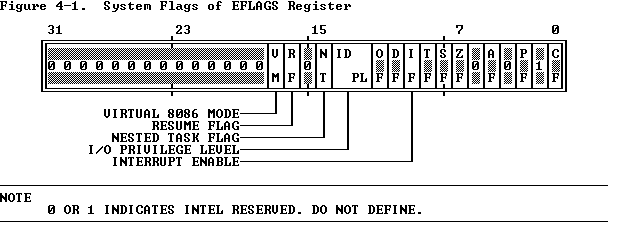up:
Chapter 4 -- Systems Architecture
prev: Chapter 4 -- Systems Architecture
next: 4.2 Systems Instructions
4.1 Systems Registers
The registers designed for use by systems programmers fall into these
classes:
- EFLAGS
- Memory-Management Registers
- Control Registers
- Debug Registers
- Test Registers
4.1.1 Systems Flags
The systems flags of the EFLAGS register control I/O, maskable interrupts,
debugging, task switching, and enabling of virtual 8086 execution in a
protected, multitasking environment. These flags are highlighted in
Figure 4-1
.
-
IF
(Interrupt-Enable Flag, bit 9)
-
Setting IF allows the CPU to recognize external (maskable) interrupt
requests. Clearing IF disables these interrupts. IF has no effect on
either exceptions or nonmaskable external interrupts . Refer to
Chapter 9
for more details about interrupts .
-
NT
(Nested Task, bit 14)
-
The processor uses the nested task flag to control chaining of
interrupted and called tasks. NT influences the operation of the
IRET
instruction . Refer to
Chapter 7 and
Chapter 9
for more information on
nested tasks.
-
RF
(Resume Flag, bit 16)
-
The RF flag temporarily disables debug exceptions so that an instruction
can be restarted after a debug exception without immediately causing
another debug exception . Refer to
Chapter 12
for details .
-
TF
(Trap Flag, bit 8)
-
Setting TF puts the processor into single-step mode for debugging. In
this mode, the CPU automatically generates an exception after each
instruction, allowing a program to be inspected as it executes each
instruction. Single-stepping is just one of several debugging features of
the 80386 . Refer to
Chapter 12
for additional information .
-
VM
(Virtual 8086 Mode, bit 17)
-
When set, the VM flag indicates that the task is executing an 8086
program . Refer to
Chapter 14
for a detailed discussion of how the 80386
executes 8086 tasks in a protected, multitasking environment.

4.1.2 Memory-Management Registers
Four registers of the 80386 locate the data structures that control
segmented memory management:
-
GDTR
Global Descriptor Table Register
-
LDTR
Local Descriptor Table Register
-
These registers point to the segment descriptor tables GDT and LDT.
Refer to
Chapter 5
for an explanation of addressing via descriptor
tables.
-
IDTR
Interrupt Descriptor Table Register
-
This register points to a table of entry points for interrupt handlers
(the IDT ) . Refer to
Chapter 9
for details of the interrupt mechanism .
-
TR
Task Register
-
This register points to the information needed by the processor to define
the current task . Refer to
Chapter 7
for a description of the
multitasking features of the 80386.
4.1.3 Control Registers
Figure 4-2
shows the format of the 80386 control registers CR0, CR2, and
CR3. These registers are accessible to systems programmers only via variants
of the MOV instruction, which allow them to be loaded from or stored in
general registers; for example:
MOV EAX, CR0
MOV CR3, EBX
CR0 contains system control flags, which control or indicate conditions
that apply to the system as a whole, not to an individual task.
-
EM
(Emulation, bit 2)
-
EM indicates whether coprocessor functions are to be emulated. Refer to
Chapter 11
for details .
-
ET
(Extension Type, bit 4)
-
ET indicates the type of coprocessor present in the system (80287 or
80387 ) . Refer to
Chapter 11 and
Chapter 10 for details.
-
MP
(Math Present, bit 1)
-
MP controls the function of the WAIT instruction, which is used to
coordinate a coprocessor . Refer to
Chapter 11
for details .
-
PE
(Protection Enable, bit 0)
-
Setting PE causes the processor to begin executing in protected mode.
Resetting PE returns to real-address mode . Refer to
Chapter 14
and
Chapter 10
for more information on changing processor modes .
-
PG
(Paging, bit 31)
-
PG indicates whether the processor uses page tables to translate linear
addresses into physical addresses . Refer to
Chapter 5
for a description
of page translation; refer to
Chapter 10
for a discussion of how to set
PG.
-
TS
(Task Switched, bit 3)
-
The processor sets TS with every task switch and tests TS when
interpreting coprocessor instructions . Refer to
Chapter 11
for details .
CR2 is used for handling page faults when PG is set. The processor stores
in CR2 the linear address that triggers the fault . Refer to
Chapter 9
for a
description of page-fault handling.
CR3 is used when PG is set. CR3 enables the processor to locate the page
table directory for the current task . Refer to
Chapter 5
for a description
of page tables and page translation.

4.1.4 Debug Register
The debug registers bring advanced debugging abilities to the 80386,
including data breakpoints and the ability to set instruction breakpoints
without modifying code segments . Refer to
Chapter 12
for a complete
description of formats and usage.
4.1.5 Test Registers
The test registers are not a standard part of the 80386 architecture. They
are provided solely to enable confidence testing of the translation
lookaside buffer (TLB), the cache used for storing information from page
tables .
Chapter 12
explains how to use these registers .
up:
Chapter 4 -- Systems Architecture
prev: Chapter 4 -- Systems Architecture
next: 4.2 Systems Instructions


